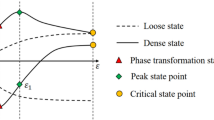Abstract
The thin-layer interface model for filled joints is extended to analyze shear wave propagation across filled rock joints when the interfacial shear strength between the filling material and the rocks is taken into account. During the wave propagation process, the two sides of the filled joint are welded with the adjacent rocks first and slide on each other when the shear stress on the joint is greater than the interfacial shear strength. By back analysis, the relation between the shear stress and the relative tangential deformation of the filled joints is obtained from the present approach, which is shown as a cycle parallelogram. Comparison between the present approach and the existing method based on the zero-thickness interface model indicates that the present approach is efficient to analyze shear wave propagation across rock joints with slippery behavior. The calculation results show that the slippery behavior of joints is related to the interfacial failure. In addition, the interaction between the shear stress wave and the two sides of the filling joint influences not only the wave propagation process but also the dynamic response of the filled joint.










Similar content being viewed by others
References
Bandis SC, Barton NR, Lumsden AC (1983) Fundamental of rock joint deformation. Int J Rock Mech Min Sci Geomech Abstr 20:249–268
Barton N (1973) Rock mechanics review, the shear strength of rock and rock joints. Int J Rock Mech Min Sci Geomech Abstr 13:255–279
Bedford A, Drumheller DS (1994) Introduction to elastic wave propagation. Wiley, Chichester
Brown SR, Scholz CH (1986) Closure of rock joints. J Geophys Res 91:4939–4948
Cook NGW (1992) Natural joint in rock: mechanical, hydraulic and seismic behaviour and properties under normal stress. Int J Rock Mech Min Sci Geomech Abstr 29(3):198–223
Desai CS, Zaman MM, Lightner JG, Siriwardance HJ (1984) Thin-layer element for interfaces and joints. Int J Numer Anal Mech Geomech 8(1):19–43
Ewing WM, Jardetzky WS, Press F (1957) Elastic waves in layered media. McGraw-Hill, New York
Fehler M (1982) Interaction of seismic-waves with a viscous-liquid layer. Bull Seismol Soc Amer 72:55–72
Gentier S, Billaux D, van Vliet L (1989) Laboratory testing of the voids in a fracture. Rock Mech Rock Eng 22:149–157
Hopkins DL (2000) The implications of joint deformation in analyzing the properties and behavior of fractured rock masses, underground excavations and faults. Int J Rock Mech Min Sci 37:175–202
Kolsky H (1953) Stress Waves in Solids. Clarendon Press, Oxford
Li JC, Ma GW, Zhao J (2011) Analysis of stochastic seismic wave interaction with a slippery rock fault. Rock Mech Rock Eng 44(1):85–92
Li JC, Li HB, Ma GW, Zhao J (2012) A time-domain recursive method to analyse transient wave propagation across rock joints. Geophys J Int 188(2):631–644
Li JC, Wu W, Li HB, Zhu JB, Zhao J (2013) A thin-layer interface model for wave propagation through filled rock joints. J Appl Geophys 91:31–38
Li JC, Li HB, Jiao YY, Liu YQ, Xia X, Yu C (2014) Analysis for oblique wave propagation across filled joints based on thin-layer interface model. J Appl Geophys 102:39–46
Miller RK (1977) An approximate method of analysis of the transmission of elastic waves through a frictional boundary. J Appl Mech -Trans ASME 44(4):652–656
Miller RK (1978) The effects of boundary friction on the propagation of elastic waves. Bull Seismol Soc Am 68(4):987–998
Perino A, Orta R, Barla G (2012) Wave propagation in discontinuous media by the scattering matrix method. Rock Mech Rock Eng 45(5):901–918
Pyrak-Nolte LJ, Morris JP (2000) Single fractures under normal stress: the relation between fracture specific stiffness and fluid flow. Int J Rock Mech Min Sci 37:245–262
Pyrak-Nolte LJ, Myer LR, Cook NGW (1990a) Transmission of seismic-waves across single natural fractures. J Geophys Res 95(B6):8617–8638
Pyrak-Nolte LJ, Myer LR, Cook NGW (1990b) Anisotropy in seismic velocities and amplitudes from multiple parallel fractures. J Geophys Res 95(B7):11345–11358
Ranjith K, Rice J (2001) Slip dynamics at an interface between dissimilar materials. J Mech Phys Solids 49(2):341–361
Schoenberg M (1980) Elastic wave behavior across linear slip interfaces. J Acoust Soc Am 68(5):1516–1521
Sharma KG, Desai CS (1992) Analysis and implementation of thin-layer element for interfaces and joints. J Eng Mech-ASCE 118(12):2442–2462
Uenishi K, Rossmanith HP, Scheidegger AE (1999) Rayleigh pulse-dynamic triggering of fault slip. Bull Seism Soc Am 89(5):1296–1312
Zhao J (1997) Joint matching and shear strength, part A: joint matching coefficient (JMC). Int J Rock Mech Min Sci 34:173–178
Zhao XB, Zhao J, Hefny AM, Cai JG (2006) Normal transmission of S-wave across parallel fractures with coulomb slip behavior. J Eng Mech ASCE 132(6):641–650
Zhao XB, Zhu JB, Zhao J, Cai JG (2012) Study of wave attenuation across parallel fractures using propagator matrix method. Int J Numer Anal Meth Geomech 36(10):1264–1279
Zhu JB, Perino A, Zhao GF, Barla G, Li JC, Ma GW, Zhao J (2011) Seismic response of a single and a set of filled joints of viscoelastic deformational behaviour. Geophys J Int 186:1315–1330
Acknowledgments
The author acknowledges the support of Major State Basic Research Project of China (2015CB057905, 2010CB732001) and Chinese National Science Research Fund (41272348, 51025935).
Author information
Authors and Affiliations
Corresponding author
Rights and permissions
About this article
Cite this article
Li, J.C., Liu, T.T., Li, H.B. et al. Shear Wave Propagation Across Filled Joints with the Effect of Interfacial Shear Strength. Rock Mech Rock Eng 48, 1547–1557 (2015). https://doi.org/10.1007/s00603-014-0662-1
Received:
Accepted:
Published:
Issue Date:
DOI: https://doi.org/10.1007/s00603-014-0662-1




